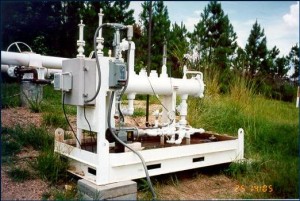 Recent advancements in corrosion inspection and monitoring include inline inspection (ILI), leak detection, maintenance pigging, and online corrosion monitoring system for both internal corrosion and cathodic protection measurement.
Recent advancements in corrosion inspection and monitoring include inline inspection (ILI), leak detection, maintenance pigging, and online corrosion monitoring system for both internal corrosion and cathodic protection measurement.
EnhanceCo provides a wet gas or oil pipeline monitoring system based on a sophisticated system which replicates the line while bypassing fluids, measuring corrosion rates in a chamber operating at system pressure and temperature, and returning the gas and fluid back into the pipeline. This innovation has contributed to the advancement of internal corrosion monitoring services.
Included in the chamber of the pipeline monitoring system are a number of corrosion monitoring equipment and tools for corrosion measurement and analysis.
- Weight loss corrosion coupons. This group of coupons is mounted across the diameter of the vessel and provides corrosion data from the water, oil, and gas phases of the production stream. A separate corrosion coupon is attached so that it floats freely within the fluid stream. This is used to measure corrosion rates in any deposits accumulating inside the chamber.
- Galvanic Probe. Galvanic probes measures differences in electrical current passing through the water phase. This change in current is often indicative of levels of dissolved oxygen (O2) within the system. Oxygen is extremely corrosive to steel.
- Linear Polarization Resistance Probe (LPR) and/or Electrical Resistance (ER) Probe. The main difference is that the element of the linear polarization resistance probe (LPR) must be in an electrolyte and provides real time monitoring corrosion rates, while the electrical resistance probe (ER) measures the increase in resistance as the monitoring element corrodes over time. Both techniques provide information as to the corrosiveness of the pipeline fluid.
- Deposit analysis. All oil pipelines tend to accumulate solids. These solids consist of both the organic and inorganic deposits usually associated with the production of oil and gas. Determining the composition of these solids assists in understanding the amount and type of corrosion mechanisms operating within a particular production system. Through years of operating experience we have found that corrosion rates within these deposits may be orders of magnitude higher than corrosion rates in the bulk fluid, and often contribute to under deposit corrosion and/or oxygen differential corrosion.
- Water analysis. Analysis of the produced water will provide significant data as to the corrosiveness of the fluid. Chloride, pH, alkalinity, and scale forming compounds all contribute to this information.
- Bacteria. Bacterial analysis is routinely conducted on accumulated water: this includes both aerobic and anaerobic acid producing bacteria and sulfate reducing bacteria (SRB). By swabbing corrosion coupons or taking deposits from other surfaces we can measure both sessile and planktonic levels of bacteria. And with additional existing technology, we are now able to measure the DNA of these microorganisms.

